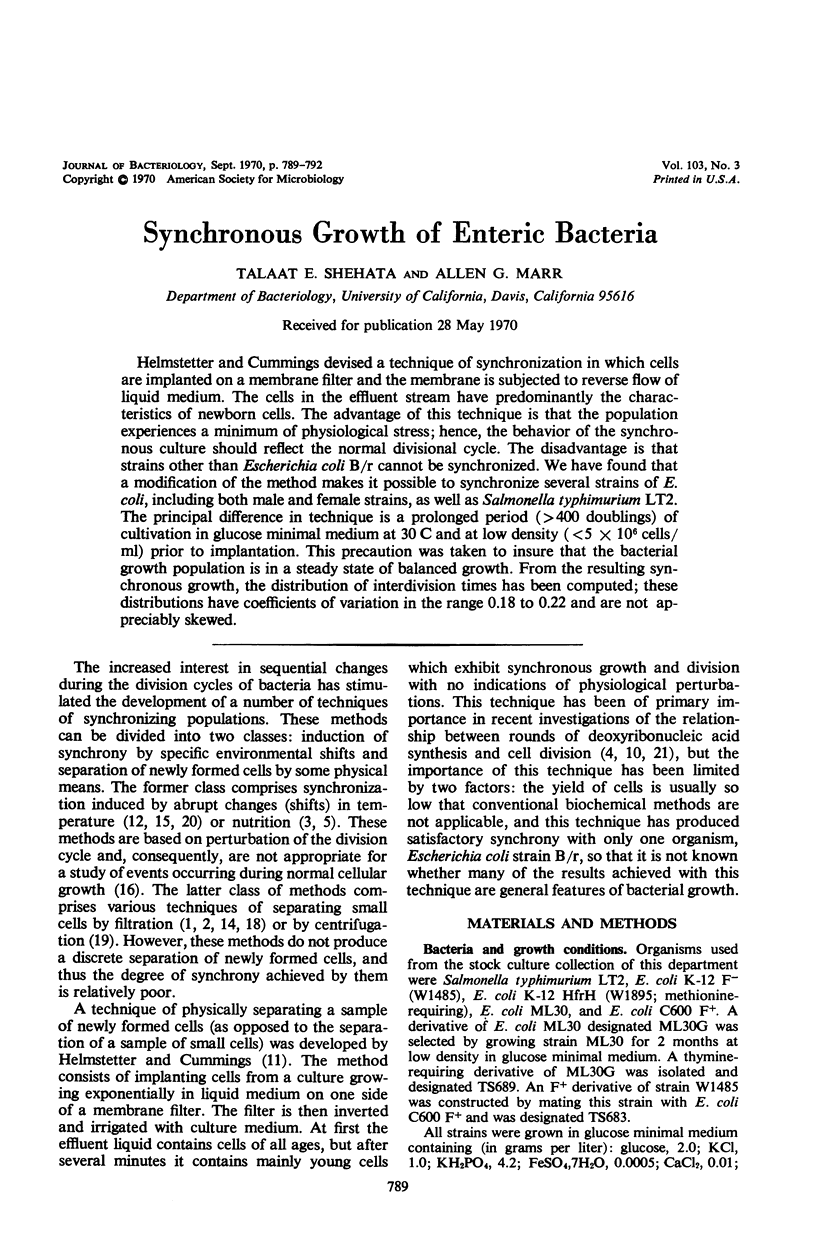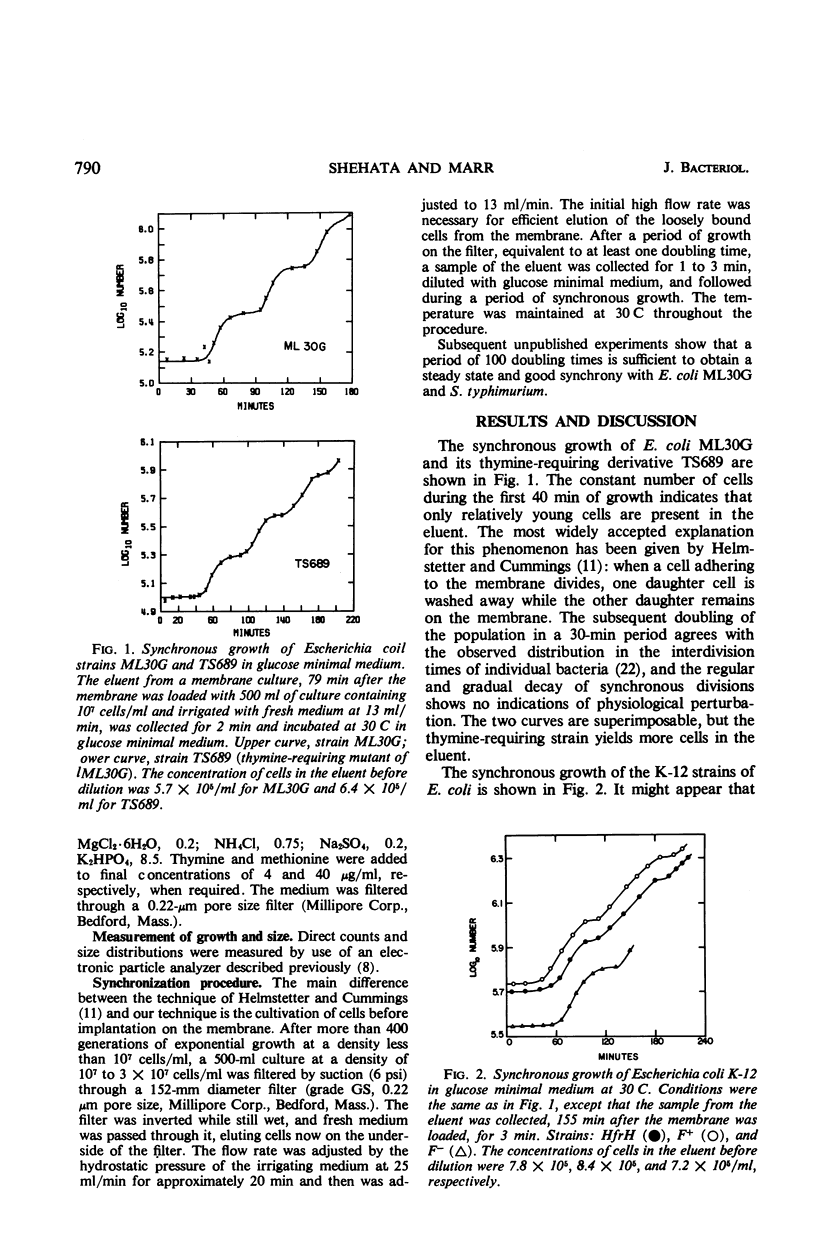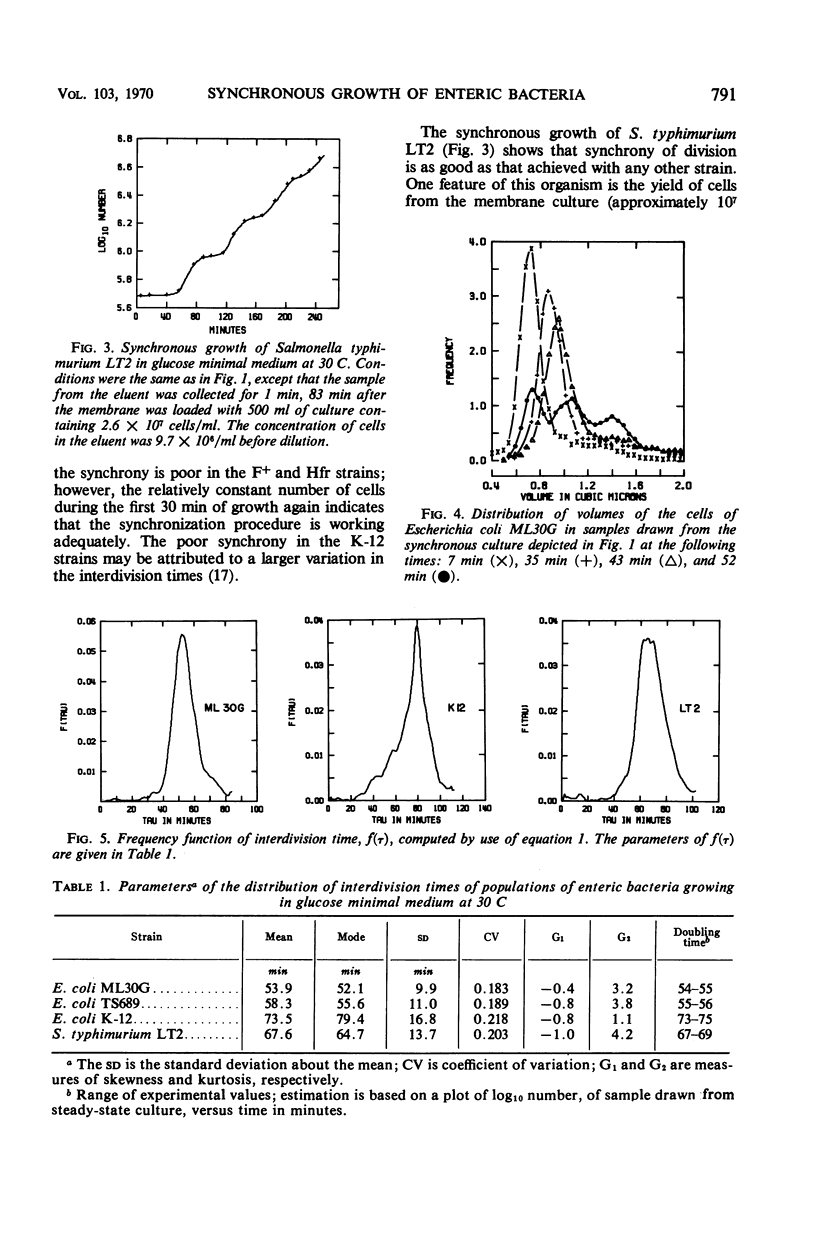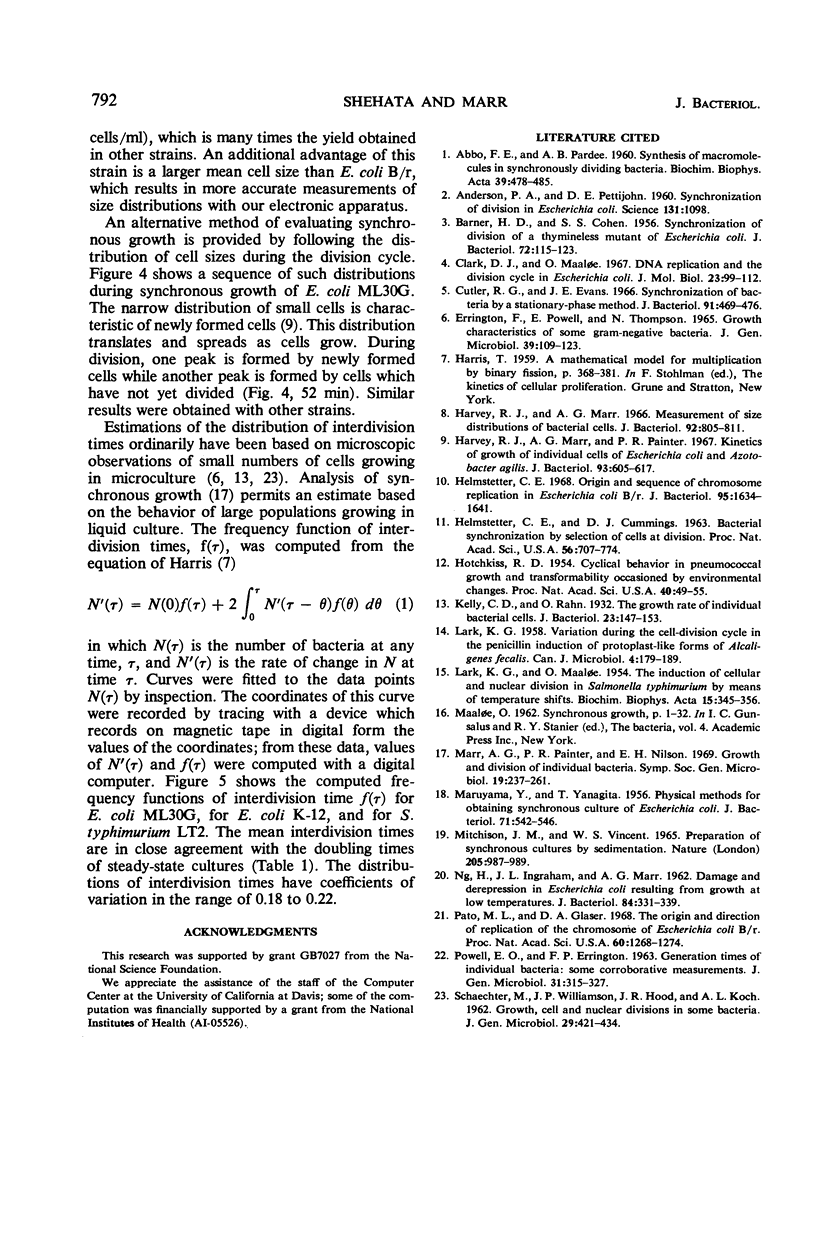Abstract
Helmstetter and Cummings devised a technique of synchronization in which cells are implanted on a membrane filter and the membrane is subjected to reverse flow of liquid medium. The cells in the effluent stream have predominantly the characteristics of newborn cells. The advantage of this technique is that the population experiences a minimum of physiological stress; hence, the behavior of the synchronous culture should reflect the normal divisional cycle. The disadvantage is that strains other than Escherichia coli B/r cannot be synchronized. We have found that a modification of the method makes it possible to synchronize several strains of E. coli, including both male and female strains, as well as Salmonella typhimurium LT2. The principal difference in technique is a prolonged period (>400 doublings) of cultivation in glucose minimal medium at 30 C and at low density (<5 × 106 cells/ml) prior to implantation. This precaution was taken to insure that the bacterial growth population is in a steady state of balanced growth. From the resulting synchronous growth, the distribution of interdivision times has been computed; these distributions have coefficients of variation in the range 0.18 to 0.22 and are not appreciably skewed.
Full text
PDF



Selected References
These references are in PubMed. This may not be the complete list of references from this article.
- ANDERSON P. A., PETTIJOHN D. E. Synchronization of division in Escherichia coli. Science. 1960 Apr 15;131(3407):1098–1098. doi: 10.1126/science.131.3407.1098. [DOI] [PubMed] [Google Scholar]
- BARNER H. D., COHEN S. S. Synchronization of division of a thymineless mutant of Escherichia coli. J Bacteriol. 1956 Jul;72(1):115–123. doi: 10.1128/jb.72.1.115-123.1956. [DOI] [PMC free article] [PubMed] [Google Scholar]
- Cutler R. G., Evans J. E. Synchronization of bacteria by a stationary-phase method. J Bacteriol. 1966 Feb;91(2):469–476. doi: 10.1128/jb.91.2.469-476.1966. [DOI] [PMC free article] [PubMed] [Google Scholar]
- ERRINGTON F. P., POWELL E. O., THOMPSON N. GROWTH CHARACTERISITICS OF SOME GRAM-NEGATIVE BACTERIA. J Gen Microbiol. 1965 Apr;39:109–123. doi: 10.1099/00221287-39-1-109. [DOI] [PubMed] [Google Scholar]
- Harvey R. J., Marr A. G. Measurement of size distributions of bacterial cells. J Bacteriol. 1966 Oct;92(4):805–811. doi: 10.1128/jb.92.4.805-811.1966. [DOI] [PMC free article] [PubMed] [Google Scholar]
- Harvey R. J., Marr A. G., Painter P. R. Kinetics of growth of individual cells of Escherichia coli and Azotobacter agilis. J Bacteriol. 1967 Feb;93(2):605–617. doi: 10.1128/jb.93.2.605-617.1967. [DOI] [PMC free article] [PubMed] [Google Scholar]
- Helmstetter C. E. Origin and sequence of chromosome replication in Escherichia coli B-r. J Bacteriol. 1968 May;95(5):1634–1641. doi: 10.1128/jb.95.5.1634-1641.1968. [DOI] [PMC free article] [PubMed] [Google Scholar]
- Hotchkiss R. D. CYCLICAL BEHAVIOR IN PNEUMOCOCCAL GROWTH AND TRANSFORMABILITY OCCASIONED BY ENVIRONMENTAL CHANGES. Proc Natl Acad Sci U S A. 1954 Feb;40(2):49–55. doi: 10.1073/pnas.40.2.49. [DOI] [PMC free article] [PubMed] [Google Scholar]
- Kelly C. D., Rahn O. The Growth Rate of Individual Bacterial Cells. J Bacteriol. 1932 Feb;23(2):147–153. doi: 10.1128/jb.23.2.147-153.1932. [DOI] [PMC free article] [PubMed] [Google Scholar]
- LARK K. G., MAALØE O. The induction of cellular and nuclear division in Salmonella typhimurium by means of temperature shifts. Biochim Biophys Acta. 1954 Nov;15(3):345–356. doi: 10.1016/0006-3002(54)90036-0. [DOI] [PubMed] [Google Scholar]
- LARK K. G. Variation during the cell-division cycle in the penicillin induction of protoplast-like forms of Alcaligenes fecalis. Can J Microbiol. 1958 Apr;4(2):179–189. doi: 10.1139/m58-018. [DOI] [PubMed] [Google Scholar]
- MARUYAMA Y., YANAGITA T. Physical methods for obtaining synchronous culture of Escherichia coli. J Bacteriol. 1956 May;71(5):542–546. doi: 10.1128/jb.71.5.542-546.1956. [DOI] [PMC free article] [PubMed] [Google Scholar]
- NG H., INGRAHAM J. L., MARR A. G. Damage and derepression in Escherichia coli resulting from growth at low temperatures. J Bacteriol. 1962 Aug;84:331–339. doi: 10.1128/jb.84.2.331-339.1962. [DOI] [PMC free article] [PubMed] [Google Scholar]
- POWELL E. O., ERRINGTON F. P. Generation times of individual bacteria: some corroborative measurements. J Gen Microbiol. 1963 May;31:315–327. doi: 10.1099/00221287-31-2-315. [DOI] [PubMed] [Google Scholar]
- Pato M. L., Glaser D. A. The origin and direction of replication of the chromosome of Escherichia coli B-r. Proc Natl Acad Sci U S A. 1968 Aug;60(4):1268–1274. doi: 10.1073/pnas.60.4.1268. [DOI] [PMC free article] [PubMed] [Google Scholar]
- SCHAECHTER M., WILLIAMSON J. P., HOOD J. R., Jr, KOCH A. L. Growth, cell and nuclear divisions in some bacteria. J Gen Microbiol. 1962 Nov;29:421–434. doi: 10.1099/00221287-29-3-421. [DOI] [PubMed] [Google Scholar]


